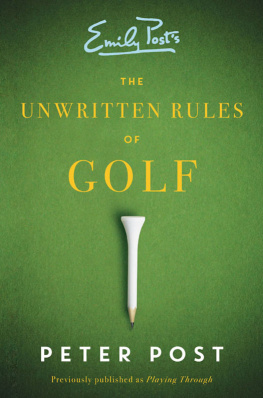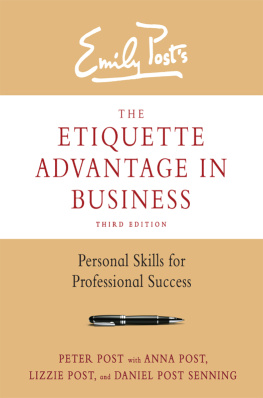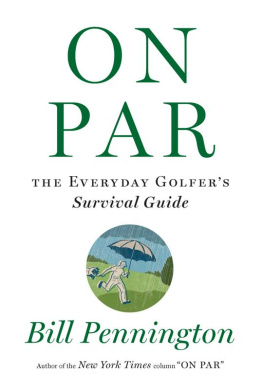
CONTENTS

Guide
A Heartfelt Thank You...
First to my brothers, Allen and Bill, and to Doug, who I met on the golf course and who I play with on Thursdays and lots of other days as well. They all spent countless hours reading the manuscript, keeping me on the right path when I strayed, and honing the advice in this book. It literally could not have been done without their efforts.
To John, the professional at the Burlington Country Club (Burlington, Vermont), to Pat, the professional at Bent Pine Golf Club (Vero Beach, Florida), and to Mark, the general manager at the Edgartown Golf Club (Edgartown, Massachusetts), who responded to my questions, talked with me whenever I asked, and provided expert advice whenever I needed it.
To Katherine, our agent, for helping to make this book possible.
To Royce, who edits every piece I write, for his willingness, as a very occasional golfer, to learn the nuances of golf etiquette and to provide the beginning golfers perspective to the advice.
To Toni and Emily at HarperCollins.
To Andy Pazder at the PGA Tour, who helped me understand the intricacies of spectator etiquette.
To the people at The Emily Post Institute for all they did to make it possible for me to concentrate on writing this book.
To Peter and Dave, who round out my regular Thursday four-some, and who have been ever so patient with me when etiquette discussions have intruded on our games. Without all those Thursdays, plus the golf outings and trips we have enjoyed over the years, this book would not have been possible.
To Bernard Magdelain for using his golf knowledge to carefully review and edit the manuscript.
To all the respondents to the Post Golf Survey. Your opinions and your stories provide the backbone of the advice here. Thank you for taking the time to respond.
To all the people, golfers and nongolfers alike, who, when they heard I was writing a book about golf etiquette, couldnt help themselves and regaled me with stories theyd heard or situations they had observed.
To Tricia, my wife, for her patience on weekends and Thursdays when Im playing golf with the boys and for playing those wonderful, relaxing nine-hole rounds that may well be the best moments I have on the course.

Playing Golf Is Simply the Icing on the Cake
Etiquette matters. Golf etiquette matters. With it, you can navigate the minefield of decisions you have to make that arent bound by the USGAs The Rules of Golf, but which will either impress or frustrate the golfers you are playing with as well as other golfers nearby. Embrace golf etiquette so that you can be the golfer who not only plays his best, but is also genuinely appreciated on the course and in the clubhouse. We all want to be the best golfer we can be, and one day I may get to a 10 handicap. But in the meantime, I have my 17-handicap game, which gets me around. Even more important, I have my friends. And they are the reason I keep going back. Sure, I want to improve my golf gamebut really I want to hear that next story or that latest joke, or simply enjoy the beauty of the course and the experience of playing a terrific sport with people who matter to me.
The rest is simply icing on the cake.

Have I Got a Story for You!
Whenever I explain to golfers (or to nongolfers, for that matter) that Im writing a book about golf etiquette, invariably they reply, Have I got a story for you! Numerous golfers have regaled me with tales of clubs broken, or tossed into trees never to come out, or vanished to the bottom of a pond. One told me of her experience driving a cart through a bunker, while another recounted the marvelous story of two eagles being scored on the same hole by people playing in the same group. Still another described a similar situation that occurred during a tournament, when two competitors each had a hole-in-one on the same hole.
In order to write this book, however, I had to go outside my own experience and the stories shared by friends and acquaintances (as great as they all were), and find out exactly what it is that really frustrates golfers. To accomplish this, I posted a survey on The Emily Post Institute Web site explaining my project and asking golfers for their input. As it turned out, the survey respondents were no different than the people Id been talking with in person. They offered a rich variety of both negative and positive stories about experiences theyd had and situations theyd observed on the golf course. Those stories make up much of the advice in this book. The anecdotes are all real, and they describe the actual behaviors that both impress and annoy golfers across the country on a daily basis.
The game of golf is unique, because it includes a social aspect thats found in no other sport. Before, during, and after the four-odd hours it takes to play eighteen holes, golfers are constantly interacting with their partners, their opponents, and other golfers on the course. They also rub elbows with golf course employees and other staff and members at the clubs where they play, and regularly run into other golfers in business and social settings totally apart from the course as well.
These interactions are all an integral part of the game, but they arent codified in the USGAs The Rules of Golf. In other sports, the focus is clearly on the competitionnot on building a relationship with your opponent at the very moment youre trying to whip him. In golf, however, the competition is only part of the story. Youre certainly trying to play your best and win, but at the same time theres an equal focus on building a good relationship with the people youre playing with. In golf, how you handle yourself as you try to beat the other guy actually matters.
I wrote this book for one reason: to help experienced golfers as well as novices alike enjoy the game of golf even more than they already do. People know theres an element of comportment to the game, but when they look for comportment advice, they hit a brick wall. There are scads of books promising to help you develop a better swing. You wont find that sort of advice hereexcept for one useful recommendation about putting (see Chapter 13, To Coach or Not to Coach? pages 136143)but you will find advice that will help you break through that brick wall. In these pages, youll be reminded (if youre an experienced golfer) or enlightened (if youre a new golfer) about such golf behaviors as:
The importance of paying up if a wager was placed on the gameeven if the person you owe is your best friend or your brother, sister, mother, or father.
The difference between friendly play and tournament play.
The difference between offering non-rules acceptable relief to an opponent in a friendly match and taking such relief yourself.
Where you should stand while others in your group tee off.
When and if you can take a mulligana do-overon the tee.















